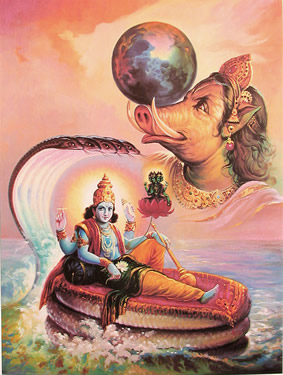 |
Essence Of
Varaha Purana
|
| 6 Regular Annual Shraddha | |
Maharshi Markandeya emphasised to Sage Gomukha about the best suitability of Brahmanas to execute Shraddh. He quoted Brahma Putra Sanandana that Brahmanas who are experts in Mantras related to ‘Trinachiket’ (Adhrvyu Yajna), ‘Trimadhu’ (Madhuvvata) and ‘Trisuparna’ or expert in Vedic Dicsiplines like Siksha, Chhand, Vyakaran, Jyotish and Shat Vedanga as also in Vedas would please Brahma Himself! Contrarily, those Brahmanas who are cheaters of friends, crooked-hand nailed, black teethed, ignorant of Vedas and Agni, thieves, Gram yachaks or beggars, remarried, those who abandoned parents, or those who have not married according to their traditions be certainly disqualified to partake in Shraddhas. The Ceremony be performed by any of the close relatives of the deceased apart from a son, such as maternal nephew, grand son of daughter, father in law, son in law, maternal uncle, failing which a Tapasvi Brahmana. Scriptures had prescribed the number of Brahmins as odd numbers, say one, three, five etc.But the Shraddh involving deities be engaged in even numbers, unless however there is a limitation in obtaining the even number. In other words, atleast one Brahmin repesenting Devas and one repesenting Pitrugan might be in order. The Brahmins invited for the Ceremony be invited atleast one day ahead. While performing the Pitru Shraddh, especially involving Deities, it is mandatory to invoke Vaishva Deva. The invocation to Agni Deva is to be performed thrice with ‘Anna’ (Cooked Rice) by the Mantras: 1) ‘Agnaye Kavyahanaya Swaha’ 2) ‘Somaya Pitrumatey Swaha’ and 3) ‘Vaivasvataya Swaha’.Then, Brahmanas (Bhoktas) are welcomed formally by relevant Mantras by washing their feet and with the request of taking Food with Bhakshya (Special Recipes, Snacks and Sweets), Bhojya (Main Course with Vegetables, Dals, and Chutneys), Lehya (Preparations which are licked with tongue), Choshya (Items which are sucked) and Paniyas or a variety of drinks with ‘Mouna’ (Silence) and comfort. There after Shraddha- Karta is to be conveyed through Rakshodhana and other Mantras recited by the Brahmanas that Bhumi is cleansed by Tilas and that the Bhokta Brahmanas are of the form of Pitaras (the departed three generations) and Deities.Tarpanas are a part of the Ceremony in favour of those deceased as detailed above. One another significant ritual relates to Pinda Daan; ‘Pindas’ made of Cooked rice or Wheat Flour along with black Sesame (Tila) seeds and water, each rounded in equal size placed on Kusa all facing South are worshipped by Dhup, Deep and Naivedyas.The Pindas represent the forefathers of three generations, viz. Father, Grand Father and Great Grand Father; in case of Shradda for mother, the two other gerations would be father’s mother and father’s grand mother ‘Bali Vaishva Deva Rituals’ mark the end of Shraddha and ‘Prasad’ as the remains of what Bhoktas and other Brahmanas had eaten is consumed. The Kartha/s should not leave the Shraddha Ceremony at any point of time till the end nor get destracted. The Entire Ceremony as a composite and uninterrupted Sacred Duty and any infringement is considered as a wanton Sin. Not only are the Forefathers affected but more importantly the Kartha and the Brahmanas responsible for the success or otherwise of the Ceremony attract the blame or the benefit. | |
 Prev:Rituals of Shraddha (Amavasya Tarpana Mantra included) Prev:Rituals of Shraddha (Amavasya Tarpana Mantra included) | |
 Next:Rituals of Shraddha (Amavasya Tarpana Mantra included)
Next:Rituals of Shraddha (Amavasya Tarpana Mantra included)